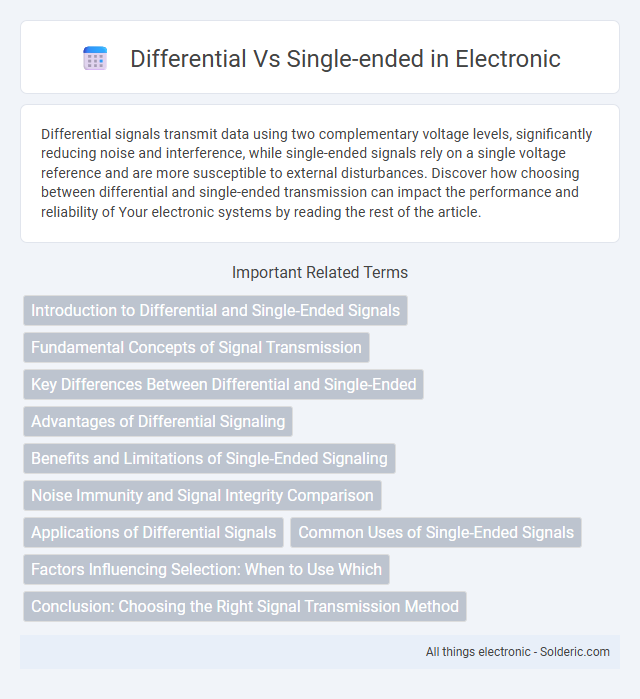Differential signals transmit data using two complementary voltage levels, significantly reducing noise and interference, while single-ended signals rely on a single voltage reference and are more susceptible to external disturbances. Discover how choosing between differential and single-ended transmission can impact the performance and reliability of Your electronic systems by reading the rest of the article.
Comparison Table
| Aspect | Differential Signaling | Single-ended Signaling |
|---|---|---|
| Signal Lines | Two complementary lines | One signal line plus ground |
| Noise Immunity | High; rejects common-mode noise | Low; susceptible to noise |
| Signal Integrity | Better over long distances | Degrades over distance |
| Power Consumption | Typically higher due to two lines | Lower power usage |
| Complexity | More complex driver and receiver circuitry | Simpler design |
| Common Applications | USB, Ethernet, PCIe, RS-485 | Analog audio, simple GPIOs, UART |
| Cost | Higher due to extra components and design | Lower cost implementation |
Introduction to Differential and Single-Ended Signals
Differential signals transmit data using two complementary voltage levels, enhancing noise immunity and signal integrity by measuring the voltage difference between paired conductors. Single-ended signals rely on one voltage level referenced to a common ground, making them more susceptible to electromagnetic interference and ground noise. Understanding the fundamental distinction between differential and single-ended signaling is crucial for optimizing electronic communication and minimizing signal degradation.
Fundamental Concepts of Signal Transmission
Differential signal transmission involves sending two complementary signals on paired conductors, enhancing noise immunity by allowing the receiver to detect the voltage difference between them, which cancels out common-mode noise. In contrast, single-ended transmission sends a single signal referenced to a common ground, making it more susceptible to electromagnetic interference and signal degradation over long distances. The fundamental distinction lies in differential signaling's ability to improve signal integrity, crucial for high-speed and low-noise communication systems.
Key Differences Between Differential and Single-Ended
Differential signals use two complementary voltage lines that transmit the same signal in opposite polarities, enhancing noise immunity and signal integrity, especially in high-speed data transmission. Single-ended signals rely on a single voltage line referenced to ground, making them more susceptible to electromagnetic interference and signal degradation over long distances. Choosing differential signaling can improve your system's performance by minimizing noise and crosstalk compared to single-ended configurations.
Advantages of Differential Signaling
Differential signaling offers superior noise immunity by transmitting two complementary signals, which allows common-mode noise to be effectively canceled out, resulting in enhanced signal integrity over long distances. It provides reduced electromagnetic interference (EMI) emissions, making it ideal for high-speed data communication in electrically noisy environments. The improved signal-to-noise ratio and enhanced data reliability make differential signaling a preferred choice in applications such as Ethernet, USB, and high-frequency analog circuits.
Benefits and Limitations of Single-Ended Signaling
Single-ended signaling offers simplicity and cost-effectiveness by using a single conductor referenced to ground, making it ideal for short-distance, low-frequency applications. Its limitations include susceptibility to electromagnetic interference and noise, resulting in reduced signal integrity over longer distances or in electrically noisy environments. This signal degradation can affect data accuracy and reliability compared to the noise-resistant differential signaling method.
Noise Immunity and Signal Integrity Comparison
Differential signaling offers superior noise immunity compared to single-ended signals by transmitting two complementary signals, allowing common-mode noise to be effectively rejected, which enhances signal integrity in electrically noisy environments. Single-ended signals, referencing a common ground, are more susceptible to external electromagnetic interference and ground noise, leading to potential data corruption and reduced reliability. Choosing differential signaling can significantly improve your system's robustness and maintain signal quality over longer distances or in high-interference conditions.
Applications of Differential Signals
Differential signals are widely used in high-speed communication systems, including Ethernet, USB, and HDMI, due to their superior noise immunity and ability to maintain signal integrity over long distances. Industrial automation and sensor interfaces also rely on differential signaling to enhance data accuracy in electrically noisy environments. Audio equipment and instrumentation benefit from differential signals to reduce electromagnetic interference and ensure precise signal transmission.
Common Uses of Single-Ended Signals
Single-ended signals are commonly used in low-speed, short-distance applications such as audio equipment, consumer electronics, and basic sensor interfaces where simplicity and cost-effectiveness are priorities. Your devices often rely on single-ended signaling for connecting components within the same circuit board, where electromagnetic interference is minimal. Choosing single-ended signals suits environments where noise immunity is less critical, ensuring straightforward design and ease of troubleshooting.
Factors Influencing Selection: When to Use Which
Factors influencing the selection between differential and single-ended signaling include noise immunity, signal integrity, and cable length. Differential signaling is preferred in high-interference environments and long-distance transmissions due to its superior noise rejection and minimal electromagnetic interference. Single-ended signaling is suitable for short distances and low-cost applications where noise and signal degradation are minimal.
Conclusion: Choosing the Right Signal Transmission Method
Differential signal transmission offers superior noise immunity and higher data integrity, making it ideal for long-distance or high-speed communication in environments with electromagnetic interference. Single-ended signaling provides a simpler, cost-effective solution suitable for short-distance or low-frequency applications with minimal noise concerns. Selecting the right method depends on specific system requirements, such as signal integrity, environmental conditions, and cost constraints.
Differential vs Single-ended Infographic

 solderic.com
solderic.com